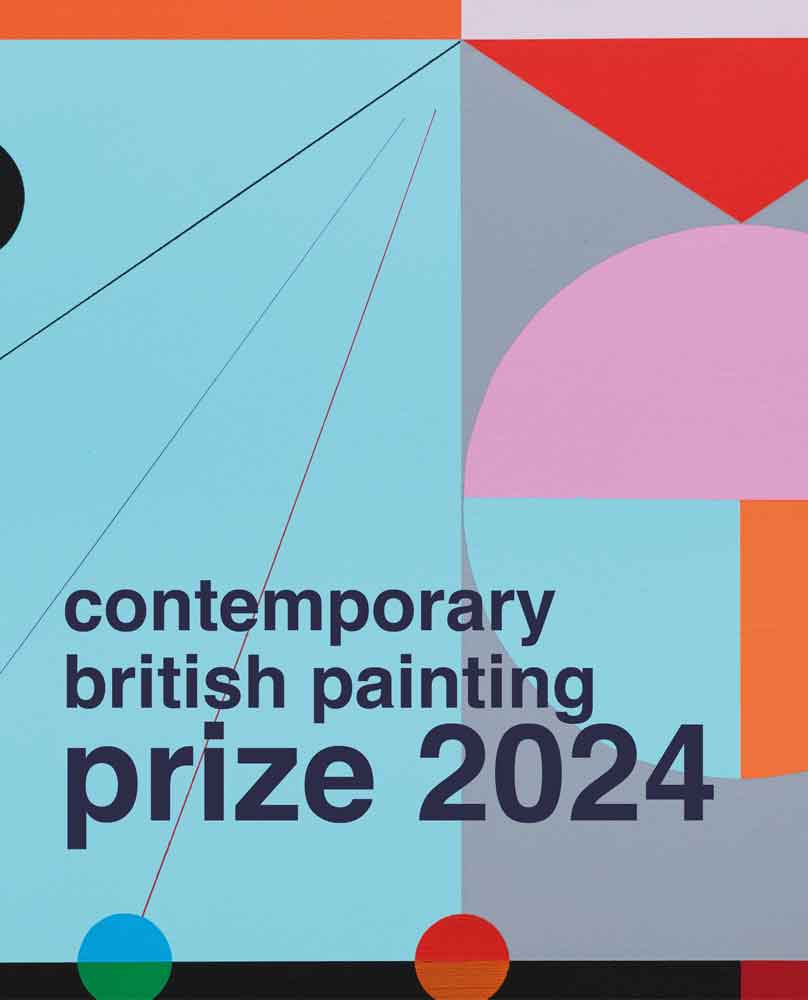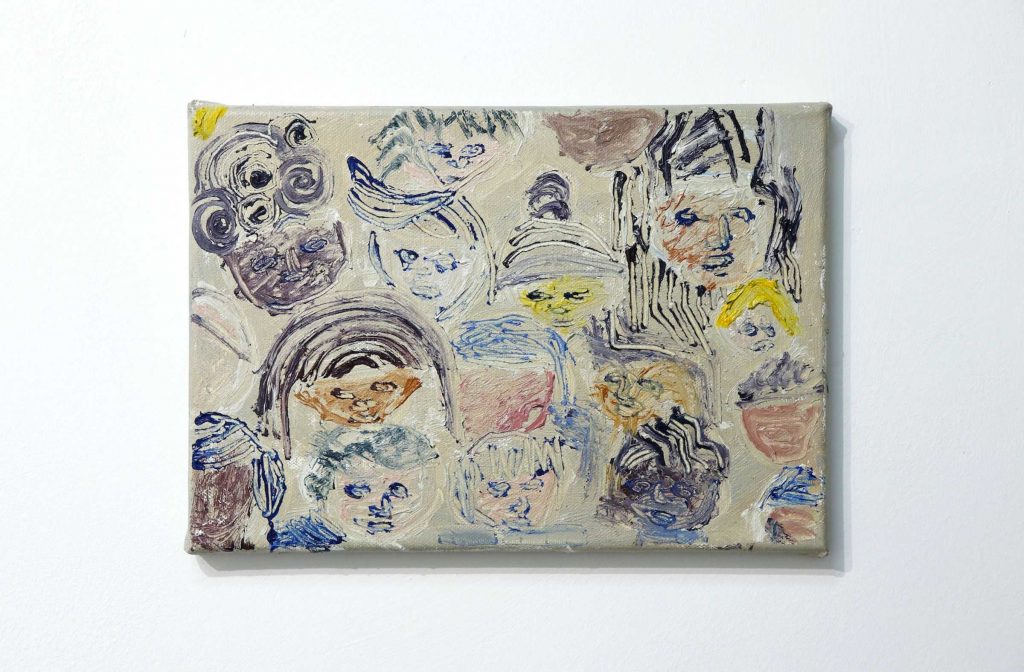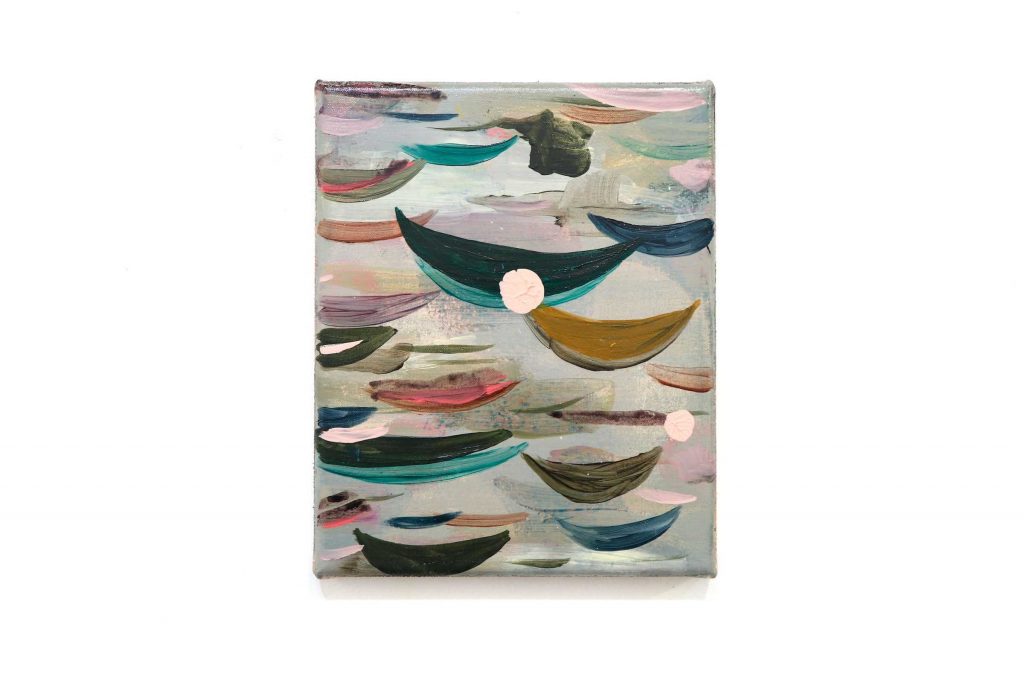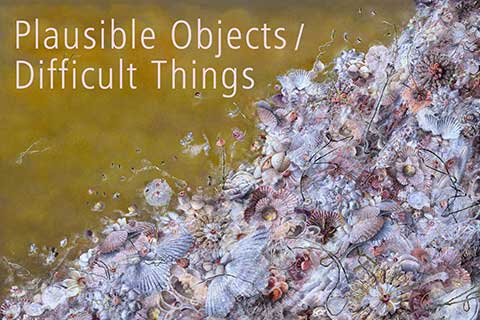Stand Close and Breathe Me In
Venue: Oceans Apart, OA Studios, 24-26 King Street, Salford M3 7DG
Exhibition dates: 25 June – 25 July 2021
Stand Close and Breathe Me In is a group exhibition of paintings which explores the collective spirit of small scale imagery within the context of a painting-viewer relationship. These paintings draw you in. They initiate an intimate response and engage the viewer in the act of looking. They arrest us at close quarters via the smallest of painterly activities and devices.
Each painting punctuates the next and radiates into the space and into each other. They converse and mingle, sending out messages like invisible rays. They enter the body through the eyes and remain there as propositions, questions and after-images.
These paintings remind us that ‘size isn’t everything’. Up close, we’re able to scrutinise content and the manner in which the paintings were made. We experience the surface as a consequence of process, feeling each painting’s meaning through its distinctive mode of making.
At a distance, we witness the bigger picture, where the paintings converse silently at arms length, collaborating as dots and dashes and through repetition and strength in numbers. Approaching these paintings they begin to reveal and conceal themselves simultaneously. Clarity is administered in their obscurity and abstraction before we back away to achieve a sense of perspective in the collective.

Exhibiting artists: Julian Brown, Kena Brown, Ruth Calland, Andrew Crane, Jeff Dellow, Lisa Denyer, Rosalind Faram, Susie Hamilton, Alex Hanna, David Lock, David Manley, Enzo Marra, Gideon Pain, Alison Pilkington, James Quin, Dan Samuel Thomas, Katie Trick, Rhys Trussler, Grant Watson, Lily-Ella Westacott, Casper White and Dylan Williams.
Curated by Enzo Marra in conjunction with Contemporary British Painting.
Venue: Oceans Apart, OA Studios, 24-26 King Street, Salford M3 7DG
Exhibition dates: 25 June – 25 July 2021
By appointment only – please email oceansapartgallery@gmail.com
Socially distanced Finissage: 23 July 2021, 6pm – 9pm
Website: https://www.oceansapart.uk/
Little did we know
Stand Close and Breathe Me In, Oceans Apart until 25th July 2021
Located on the currently blocked-off King Street in Salford, a stride across the river off Blackfriars, the building that houses Oceans Apart is both gallery and studio space to 18 artists. It appears red-brick, humble and resolute amidst the ascending towers around it. There’s a car park next door, £5 to park all day, and there are hi-vis construction workers about. The vicinity is in transition, in-between times and there could be no better setting for an exhibition like this.
‘Stand Close and Breathe Me In’ presents twenty two paintings no bigger than 30cm on the longest side, each by a different artist and brought together by Enzo Marra, artist and curator, in association with Contemporary British Painting. Is the only reason these paintings have been brought together because of their stature? It’s up to the viewer to work out what holds this gathering together. Like walking into a party and not knowing who anyone is, it’s an unnerving experience. These paintings are looking at you and waiting…blinking even.
For they are alive with possibility, a small island, a postcard from a far-off place, messages scratched onto a cubicle door, a faded photo, a drawn-out drunken explanation, a patchwork of studio ephemera and scribbled notes. Visually intriguing beyond words, painted intimacies, hints and allegations, windows into dreams. Mesmerising works, all different, not the same thought amongst them. Well maybe one, which says… look love, this is what painting can be.
‘Yellow Skirt’ by Rosalind Faram, an almost famous fashion-forward figure, is styling it out on a bright coloured backdrop, hands on hips, blank expression of influencer-confidence. A ‘neo-geo’ look with the position of the arms matching the triangles in the top and there’s a triangle in the split of the yellow skirt. Big boots with a shiny toe, black hair parted in the middle.
A dog wanders over the street towards us in the foreground of Dan Samuel Thomas’, loosely painted scene ‘Cardiff in Lockdown’. Grey and yellow paint loosely laid with white of the paper showing through and a red under-staining where the road and pavement meet. In front of a building stand four figures, we can see their pink hands are animated, one might be playing a musical instrument. We make the leap, but then the stain, the terrible stain.
Stone-clouds hang in a grey sky, Boden meets Go Outdoors as a catalogue collection of clothes is spread over the top of a tent; including two pairs of jeans and some pink trousers, a dull green striped jumper, and a brown tubular skirt are placed with directional intent, like a shell pattern. We can’t see the front of ‘Phil’s Tent’ by Gideon Pain, but there is a sense it is open faced and alert, two antennae lean forwards. It’s not pitched, it’s moving across the rubbly red-brown ground.
Tents, sleeping bags and cardboard boxes have become symbols of displaced lives, so when Rhys Trussler puts his figure into a sleeping bag in ‘Dick’ what does it do to the reading of the painting? Is it even a sleeping bag? It’s painted like water and it appears to float on darkness. Head inside a cardboard box, handholes replace the mouth, arms bare, an unidentifiable figure collecting the drops of a dripping hand-drawn phallus. It feels tragic and surreal.
‘Eagle’ by Andrew Crane feels like a painting that has collapsed into nothing at all. It might even be Isaro English Red that is painted crudely onto a mismatched plaster ground and it is erasing what comes after ENG. It pushes us towards something we know and it can be felt as much as thought.
The body language of the lonely figure standing hunched in Susie Hamilton’s ‘Shopper’, an aged painting from 2010, reads careworn, and might at first invoke pathos in the viewer. Only she’s had a cut and colour and she’s wearing a good coat that matches the rest of her beige outfit. Look closer and her legs are missing, is she seen only by her hair, coat and bag? So many questions this painting provokes, yet so little paint is used in the making of it.
Identity is questioned with a seemingly collaged portrait, tightly cropped and hirsute, oh you’ve got blue eyes oh you’ve got grey eyes and a suggestion of a football shirt – tribal then, profiling, mono/colour, so many possibilities and suggestions, lots of face value in David Lock’s ‘Misfit (Bear)’ oil painting.
Could these paintings ever be big? Well no. Their size is part of their making and would you even want to? There’s a definite assuredness in exactly what they are. The exception might be Kena Brown’s tiny little 15x13cm abstract painting which is like a piece missing from a larger piece of work. Paint thickly applied so that sometimes it misses, corners and edges chipped to reveal the wooden support. A suggestion of a bright turquoise sea, the work leaves one wondering whether this might be a study for a larger work, a playful material suggestion or just a note to self. Is it enough? If this was a huge painting, there would be no doubt, so does this question arise because it’s small? Size still matters then, outside this room.
But we are still here inside this small place of small paintings and what goes on out there in big painting world doesn’t matter. This is the world of the small and it feels intimate and enchanting and yet epic in its content.
In ‘Don Quixote and Sancho Panza #2’ James Quin paints a faded scene of Cervantes’ two fictional characters riding through a cloudy landscape. It is framed by blue stripes like a wallpaper and the image running over the edge of the right side. It places one fiction inside another fiction.
In Dylan Williams’ ‘Self Portrait with Grandfather’ a double portrait of tin hatted figures, vaguely familiar, painted in grey, one carrying an arrow the other a stick. Red paint daubs the sky behind them and pools in the lower third. Eyes right serious black and intent, eyes left, white and fearful.
Sopocani is the name of a 13th century Serbian monastery, so why this is the title of this oil painting on a placemat by David Manley, I can’t quite tell. An image of what a computer of the future looked like to people in the past, framed by the words ‘In the artist’s right hand beat the pulses of the world’. Are those flashing lights like creative impulses, reduced to a digital dimension, or is it an artist’s computerised grimace?
Another painting missing a head from its central figure, and in this case it’s a significant one because what is Medusa without her head? Cropped from the top of the painting and not only that sliced by a thick black line that that bleeds into her neck, the figure in Ruth Calland’s ‘Mammy Two Shoes’ is (still) standing against a luminous blue and wearing a bright blue knee-length flouncy dress and large boots. Calland returns Medusa’s snakes to her body with loose painterly abandon, we can tell she loves to paint.
The expression of feeling in paint and exploring what paint can do within the four walls of a flat surface, how it can tug at our emotional and psychological strings by pure suggestion, makes it a will-o’-the-wisp medium.
And so it doesn’t phase us to see slivers of oceanic watermelon slices float before our eyes in ‘Portrait Sea’ by Julian Brown. Two pink blobs, the act of application apparent, interrupts the space. Behind all this a thin luminous green-grey wash deepens the feeling of immersion. We feel safe on these arcs of the ocean and can cope with the mild threat of the blobs, it’s not an unwelcome feeling.
Jeff Dellows’ playful harmony, ‘Prospects’ is like a flag of linear restraint in which a coded system of paint is applied; black lines that curve and dip and stop to dot, speak to the crisscross form above, that reaches out to the green, but cannot touch it for the way is blocked.
Pastel semaphore flags offer a smooth passage on a sea of trowelled-on purple and fluorescent yellow-green Polyfiller in ‘Temple II’ by Lisa Denyer. Glimpses of orange-red flares signal danger. Hang on there’s a smudge, a dirty mark where I was about to sit.
This idea of where we feel we can go in a painting is used to manipulate the viewer’s response to ‘Best place to be’ by Katie Trick, landscape surrounded by pink ruched swags of an aged theatre curtain edged in red. The green paint of the hill in the inner scene has contaminated the sky and the paint is thick and crusty, too thick. The pink curtains are closing in and we could be trapped in this place forever.
Casper White plays with our emotional response to colour and bleaches it out mercilessly to create the nightmarish feeling of too much space in ‘Meissen Manufactory Harlequin with jug 1740 filmed at The Met’. Added to this is the jeopardy of the patterned figurine teetering in this translucent world in which boxes create frames, yet offer no place of safety within the space, only to lead our eyes around the painting as if by an unseen force.
This being led unwillingly into someone else’s world is exploited by an illuminated tubular form to draw in the viewer in ‘Map of 3’ by Lily-Ella Westacott. Watercolour brown wash surrounds a mountainous region, a backdrop to an enigmatic centrepiece consisting of three open-mouthed tubes that lean towards us, connected to a hovering circle at the bottom ready to suck the life out of us.
In the similarly mind-bending ‘Puzzle’, Alison Pilkington has painted three, let’s call them containers. Everything around the containers is the same colour, a light pinkish white. The larger up-in-the-air container is holding five flying or hovering triangles, a green triangle above a red triangle, in front of a shaded triangle on a yellow background. The other two containers seem to suggest these triangular forms have a life on the ground. A ghost triangle stands close to a triangle with legs and wearing heels, maybe in front of a fire where more triangles are browning on a BBQ.
In contrast it would appear we are on safe ground upon arrival at ‘Treasure Island’ by Enzo Marra, since it holds all the trademarks of a secret treasure map; palm trees, a small mountain range, a trail around the island and an X. Close up black and white shiny enamel paint is roughly applied, pull back and it gives way to a snoring pirate face. It happened again, I believed I was looking at three grey multi-storey buildings set against a very drab grey background. Until I read the title; ‘Used Pill Packs’ by Alex Hanna.
A lovely little postcard for the kids concludes the tour, ‘No Haircut’ by Grant Watson makes me think of all those schools that give kids a hard time over how they wear their hair. Faces and lots of fabulous hairstyles drawn into purple and blue paint makes this little picture alive with the spirit of hair. It’s a little statement in a big offensive world. This one should actually be massive and on a billboard.
Getting to know these paintings, spending time thinking about them afterwards is where their power kicks in. Undeniably awkward, risky and perilously close to dissolving inwardly, they come together beautifully as a community of paintings that unselfconsciously share a derision of flawlessness in favour of an undone world.
Nan Collantine
1st July 2021

















